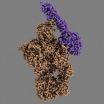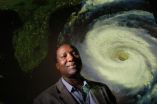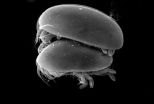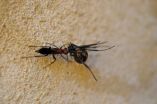New discovery related to gum disease
2012-09-11
(Press-News.org) A University of Louisville scientist has found a way to prevent inflammation and bone loss surrounding the teeth by blocking a natural signaling pathway of the enzyme GSK3b, which plays an important role in directing the immune response.
The discovery of UofL School of Dentistry researcher David Scott, PhD, and his team recently published on-line first in the journal Molecular Medicine. The finding not only has implications in preventing periodontal disease, a chronic inflammatory disease that causes tooth loss, but also may have relevance to other chronic inflammatory diseases. Since GSK3b is involved in multiple inflammatory signaling pathways, it is associated with a number of diseases and also is being tested by scientists for its impact in Alzheimer's disease, Type II diabetes and some forms of cancer, to name a few.
"The traditional approach to dealing with periodontal disease is to prevent plaque from forming at the gum-line or prevent the consequences of periodontal disease progression," Scott said. "Our approach manipulates a natural mechanism within our bodies to prevent inflammation and subsequent degradation when exposed to the bacterium P. gingivalis."
GSK3b is known to facilitate the inflammation that occurs during bacterial infections, so blocking this enzyme from completing its normal function by using the GSK3-specific inhibitor, SB216763 stopped the inflammation process and subsequent bone loss induced by the key periodontal pathogen, P. gingivalis, Scott said.
The next step is for Scott and his team to determine whether SB216763 has any side-effects or whether they need to search for a different inhibitor of GSK3b.
INFORMATION:
The article, "Inhibition of GSK3 abolishes bacterial-induced periodontal bone loss in mice" can be found on-line at http://www.molmed.org/pdfstore/12_180_Adamowicz.pdf .
END
ELSE PRESS RELEASES FROM THIS DATE:
2012-09-11
Chemicals or foods that raise estrogen levels during pregnancy may increase cancer risk in daughters, granddaughters, and even great-granddaughters, according to scientists from Virginia Tech and Georgetown University.
Pregnant rats on a diet supplemented with synthetic estrogen or with fat, which increases estrogen levels, produce ensuing generations of daughters that appear to be healthy, but harbor a greater than normal risk for mammary cancer, the researchers report in today's Nature Communications.
Although the findings have not yet been validated in humans, the ...
2012-09-11
The BP oil disaster in the Gulf of Mexico 2010 could have been avoided if the experiences of earlier disasters had been put to use, researcher Charles Woolfson, Linköping university, claims. The United States government is now accusing BP of gross negligence and deliberate misconduct, and taking the company to court.
On April 20, 2010, the Deepwater Horizon oil rig exploded in the ocean south of the southern coast of the US. The explosion led to the deaths of eleven people and an unfathomable environmental catastrophe.
Charles Woolfson, former professor of Labour Sociology ...
2012-09-11
Serious gaming can be used to enhance surgical skills, but games developed or used to train medical professionals need to be validated before they are integrated into teaching methods, according to a paper in the October issue of the surgical journal BJS.
Researchers from The Netherlands reviewed 25 research studies covering 30 serious games published between 1995 and 2012.
"Many medical professionals may still have a rather out-dated view of the average gamer as being someone who is too young to vote, afraid of daylight and busy killing mystical dwarves in their parent's ...
2012-09-11
VIDEO:
The animation shows how the MASP-2 (blue) attaches itself to the complement protein C4 (orange), and the structural rearrangements that occur in the C4 due to this. Note that although...
Click here for more information.
The complement system is part of the innate immune system and is composed of about 40 different proteins that work together to defend the body against disease-causing microorganisms. The complement system perceives danger signals in the body by recognising ...
2012-09-11
This press release is available in German.
In the wake of the terrorist attacks of September 11, 2001, many Americans started driving more due to a fear of flying – and lost their lives in traffic accidents. But why did this happen more frequently in some states than in others? And why didn't Spanish driving habits change in the same way following the 2004 train bombings in Madrid? Wolfgang Gaissmaier and Gerd Gigerenzer from the Harding Center for Risk Literacy at the Max Planck Institute for Human Development in Berlin present new findings on this topic in the ...
2012-09-11
"The most important thing for us is to raise awareness of the dangers of artificial light at night and we have already come a long way now that the American Medical Association (AMA) recently announced its new policy recognizing adverse health effects of exposure to light at night and encouraging further research into the matter," said Prof. Abraham Haim, a leading authority on light pollution, who coordinated the 21st International Congress of Zoology (ICZ) that was held last week at the University of Haifa, Israel.
The panel of world experts discussed "Light Pollution ...
2012-09-11
Researchers from North Carolina State University have developed a new method for forecasting seasonal hurricane activity that is 15 percent more accurate than previous techniques.
"This approach should give policymakers more reliable information than current state-of-the-art methods," says Dr. Nagiza Samatova, an associate professor of computer science at NC State and co-author of a paper describing the work. "This will hopefully give them more confidence in planning for the hurricane season."
Conventional models used to predict seasonal hurricane activity rely on classical ...
2012-09-11
The small ostracod Ankylocythere sinuosa measures no more than half a millimetre in length and lives on other crayfish. And, Spanish scientists have discovered it for the first time in Europe. The finding suggests that it arrived along with the invader crayfish Procambarus clarkii some 30 years ago but it is still unknown whether it can invade other crustacean species or whether it benefits or damages the expansion of the already established red swamp crayfish.
The red swamp crayfish (Procambarus clarkii) originates from the USA and Mexico and has been present in the Iberian ...
2012-09-11
Electronic Jewelry for Health
Bracelets and amulets are in the works at Dartmouth's Institute for Security, Technology, and Society (ISTS). Rather than items of mere adornment, the scientists and engineers are constructing personal mobile health (mHealth) devices—highly functional jewelry, as it were.
mHealth is a rapidly growing field where technology helps you or your physician monitor your health through mobile devices. This approach can offer more accurate and timely diagnoses as well as lower health costs. However, smartphones are often used to transmit collected ...
2012-09-11
University of Adelaide researchers say a small wasp that scientists had forgotten about for more than 200 years is now making a name for itself – as a predator of Australia's most common dangerous spider, the redback.
The wasp (Agenioideus nigricornis) was first described scientifically in 1775 by Danish entomologist Johan Christian Fabricius, thanks to samples collected in Australia during Captain Cook's first great voyage (1768).
"Since then, scientists have largely forgotten about the wasp," says Professor Andy Austin from the University of Adelaide's Australian ...
LAST 30 PRESS RELEASES:
[Press-News.org] New discovery related to gum disease




